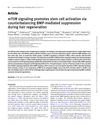TLDR The mTOR pathway may be involved in the development of hair follicle tumors, with higher activity in malignant tumors.
The study investigated the expression of phospho-S6, a marker of mTOR pathway activation, in various benign and malignant hair follicle tumors. A total of 76 cases were analyzed, including fibrofolliculomas, trichoepitheliomas, tricholemmomas, pilomatricomas, malignant proliferating tricholemmal tumors, tricholemmal carcinomas, and trichoblastic carcinomas. Results showed that all malignant tumors exhibited strong and diffuse phospho-S6 staining in 70% to 90% of tumor cells. In contrast, benign tumors showed less frequent and more patchy phospho-S6 staining. The findings suggested that phospho-S6 is differentially expressed in benign versus malignant hair follicle tumors, indicating mTOR pathway activation is more prominent in malignant cases.
 71 citations
,
January 2015 in “Journal of molecular cell biology/Journal of Molecular Cell Biology”
71 citations
,
January 2015 in “Journal of molecular cell biology/Journal of Molecular Cell Biology” mTOR signaling helps activate hair stem cells by balancing out the suppression caused by BMP during hair growth.
18 citations
,
January 2009 in “Experimental Dermatology” mTOR may link different pathways in hair follicle tumor formation.
29 citations
,
June 2015 in “Kidney International” Disrupting the Flcn gene in mice causes early kidney cysts and tumors, which can be treated with rapamycin.
39 citations
,
October 2012 in “Familial cancer” New therapies for Birt–Hogg–Dubé syndrome are being developed based on understanding the FLCN gene's role.
99 citations
,
May 2013 in “Familial cancer” People with Birt-Hogg-Dubé syndrome often have lung problems and delayed diagnosis, and better recognition of CT scan signs could improve diagnosis and management.
 72 citations
,
November 2012 in “PloS one”
72 citations
,
November 2012 in “PloS one” The protein folliculin, involved in a rare disease, works with another protein to control how cells stick together and their organization, and changes in this interaction can lead to disease symptoms.
7 citations
,
September 2013 in “Familial cancer” Birt–Hogg–Dubé syndrome is a rare genetic condition causing skin lesions, lung cysts, and a higher chance of kidney cancer.

